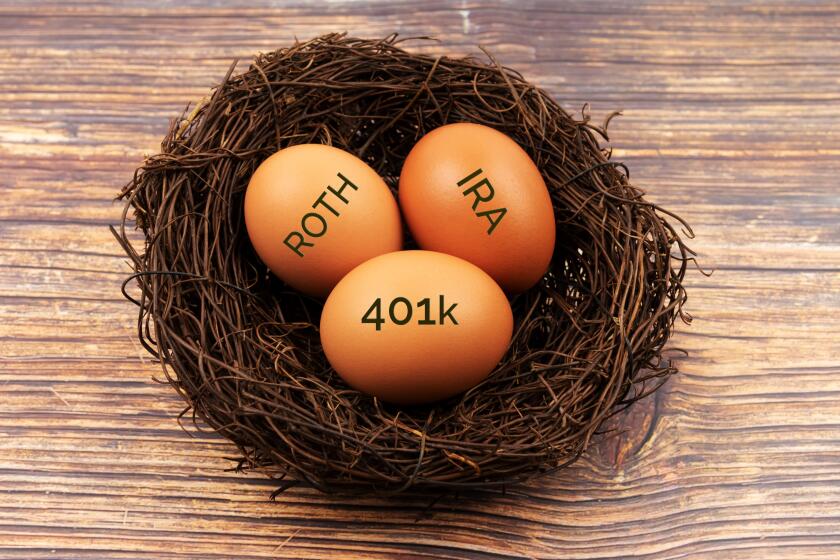YOUR MONEY : FUNDS AND 401(K)S / PAUL J. LIM : 401(k) Borrowing Isn’t Usually in Your Best Interest
- Share via
Just as stock prices have shot up during the ‘90s bull market, so too has the number of 401(k) participants borrowing from their retirement plans.
Nearly 1 out of every 3 plan participants eligible to borrow from their plans have loans outstanding, according to one recent survey, up from just 20% in 1994.
It seems that Americans have come up with any number of reasons to borrow from their nest eggs--against the best advice of financial planners.
Ironically, the single-biggest argument against borrowing from a 401(k) has been the bull market. While you may be technically “paying yourself back” 7% to 9% interest (the typical required rate) when you take out a loan against your retirement plan, you could have earned much more than that in the stock market by leaving the money in the plan in recent years.
From 1994 through 1998, plan participants could have earned a staggering 30% a year, on average, simply by investing in an index fund pegged to the Standard & Poor’s 500 blue chip stock index.
But now it’s 1999. The average domestic stock fund has generated about 9% in total returns thus far this year. Who knows if the markets can squeeze out additional gains in the fourth quarter? Or the markets could slump.
In fact, let’s assume the market is 20% lower a year from now. By borrowing against your plan now, in theory you’d be preserving your gains by pulling money out, wouldn’t you? In the meantime, you’d be paying yourself, say, 8% interest. And as you repay the loan each month or so, you’d be buying back into the market at more favorable prices.
It’s an interesting proposition, says Ted Benna, the benefits consultant who two decades ago discovered a loophole in federal tax laws that led to the creation of tax-deferred 401(k) retirement plans.
“Suppose we drop into a couple of years with negative returns,” says Benna, who now heads the 401(k) Assn., a consumer group based in Cross Fork, Pa. “It certainly has to get people to thinking, ‘Maybe I can do better borrowing.’ ”
“Hell, if I knew we were headed into a bad market, with negative returns, why not borrow some money and pay myself back?’ ” asks Dan Maul, president of the Retirement Planning Assn., an employee benefits firm in Kirkland, Wash.
Of course, it’s not that simple, Maul and Benna say.
Nonetheless, the question does focus attention on what it really means to borrow from a 401(k).
More than a loan, “borrowing from a 401(k) is really an investment decision,” says Gregory Metzger, head of Watson Wyatt Worldwide’s defined-contribution consulting practice in Los Angeles.
After all, when you take out a loan from your 401(k), you’re borrowing from yourself. Therefore, not only must you consider whether you (the borrower) really need the money, but you also need to ask yourself if you (the lender) could put the money to better use.
For instance, say the stock market doesn’t suffer losses, but simply reverts to about 11% annually, the average since 1926.
“Even at those historic rates, you’d still get nearly 50% better returns in the market than by borrowing” at about 7%, says Vernon Kozlen, executive vice president at City National Investments in Beverly Hills.
Clearly, the market would have to have a truly disappointing year, or perhaps even a down year, for borrowing to be advantageous from an investment standpoint. The trouble is, how can you predict those years with absolute certainty?
“If a person knows when the market is going to go down with great accuracy, then they probably don’t need a loan in the first place,” says Metzger.
And even if you can, financial planners say, why borrow when you can simply switch some of your investments into a money market fund or a stable value fund within your plan?
*
Incidentally, since the proliferation of 401(k)s, the S&P; 500 has really had only one down year--in 1990.
Carol Gleckman, director of KPMG’s investment consulting practice in Los Angeles, points out that “people have been talking about down markets for the past two or three years.”
Now, had you borrowed from your 401(k) in 1996, 1997 or 1998--thinking perhaps that it wouldn’t be that bad because the market couldn’t possibly return another 20%--you came out way behind.
But suppose you really need the money, perhaps to cover the costs of a medical emergency or to help pay your child’s college tuition.
Beyond any short-term “market timing” decisions you may make, what are some of things you have to consider when borrowing from your plan?
* Taxes. When you contribute money into a 401(k), you’re doing so with pretax money. However, when you repay your loan, you do so with after-tax money.
Then, down the road, when it comes time to withdraw your retirement savings, the government will tax that money once again. “So in essence, you’re double-taxed,” says Jeffrey Peak, vice president for Scudder Kemper Investments in Los Angeles.
* Compound interest. Assume that you’re repaying a loan at 8%, and the market is returning 8%, says Thomas Foster, John Hancock Retirement Services’ counsel on the Employee Retirement Income Security Act (ERISA). You’ll still end up losing by borrowing.
Why? “You’re not getting a pure 8%,” he says. “When you’re paying back a loan, you’re paying the money back incrementally.”
In other words, instead of earning 8% all at once on a large pile of money sitting in your 401(k)--and then allowing those gains to compound--you’re earning 8% on significantly smaller amounts of money as it trickles in, perhaps in monthly payments stretched out over five years. It’s compound interest working against you.
* Your cash-flow situation. If you need to reduce your future 401(k) contributions to repay your loan, chances are you’ll come out way behind--regardless what the market returns.
Yet the unfortunate reality is that many 401(k) participants who borrow against their plans end up decreasing their future contributions, says Debra Levine, assistant vice president for retirement plans for Pioneer Investment Management in Boston.
In the book “The Complete Idiot’s Guide to 401(k) Plans,” co-author Dee Lee offers an example of two hypothetical investors. The first contributes $2,000 a year to her 401(k) and earns on average 10% a year on her investment. At the end of 30 years with the company, this plan participant ends up with $343,810 in her 401(k).
*
The second hypothetical plan participant also contributes $2,000 a year and earns 10% a year on the investments. But this investor takes out a $15,000 loan against his plan in the 10th year of his employment. For the next five years, as he is repaying his loan at 7% interest, he temporarily halts contributions to his plan. At the end of 30 years, he ends up with only $284,585 in his 401(k)--or nearly $60,000 less.
* Your plan’s rules. All 401(k) plans have written, established loan procedures, which you should read before borrowing. Particular rules may sway your decision.
For instance, the vast majority of plans are structured so that you end up paying interest back to your own account. However, there may be plans in which at least some of the interest payments may go to the plan sponsor.
Also, in the vast majority of plans, money loaned is physically taken out of your account and therefore removed from the market. However, in some plans, loans may come from the plan sponsor or some third party, with your 401(k) assets serving as collateral.
Moreover, different plans take loan money from different parts of your 401(k). For instance, some plans let you choose whether to take the money from your stock fund, bond fund or money market fund investments. Others will choose for you. Still others will simply withdraw it proportionate to how the money is allocated. And still others may do it based on a last in, first out basis.
After going through these considerations, you may still decide that you have no better alternative then to borrow against your 401(k).
“If your need for money can only be satisfied with credit cards or loans with credit-card-like interest, then certainly, the 401(k) loan may be better for you,” says Watson Wyatt’s Metzger.
The key word, though, is need.
Notes Dan Maul: “I don’t think it’s wise to borrow to maximize your account’s returns. Generally, you borrow money because you need to borrow the money.”
Now, Mike Scarborough, president of Scarborough Group, a 401(k) investment advisory service based in Annapolis, Md., has a different take when it comes to these loans.
He argues that regardless of the rate of interest you pay yourself (typically, interest rates are based on prime lending rates plus a fraction), you’re effectively earning 0%.
“Remember, the funding mechanism for the interest is you,” says Scarborough. “Since you are paying the money to you, there is no increase in value of your original investments. It’s simply additional funding.” In other words, it’s not interest--it’s more principal.
Now, having said that, Scarborough says there is one “strategic” use of loans--to squeeze more principal into your 401(k).
For plan participants who have contributed the maximum allowed by the IRS and their companies--both on a pretax and an after-tax basis--to their plans, and who have exhausted all other tax-deferred avenues such as Roth IRAs, Scarborough argues that by taking out a loan and paying back the principal plus, say, 8% interest, you end up squeezing in a bit more principal than is otherwise allowed.
Says Scarborough: “Oddly enough, this is one way you can benefit from borrowing.”
*
Do you have ideas for mutual fund and 401(k) topics for this column? Times staff writer Paul J. Lim can be reached at [email protected].
More to Read
Inside the business of entertainment
The Wide Shot brings you news, analysis and insights on everything from streaming wars to production — and what it all means for the future.
You may occasionally receive promotional content from the Los Angeles Times.










